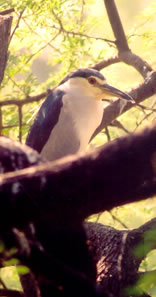|
|
|
National Chambal Sanctuary
|
 National Chambal Sanctuary on the River Chambal is a refuge for the rare and endangered
Gharial ( Gavialis gangeticus) and Ganges River Dolphin ( Platanista gangetica).
The 400 km stretch of crystal clear water also supports Marsh Crocodiles, Smooth
Coated Otters, 6 species of Terrapins/Turtles plus 250 species of birds. The Chambal
river originates in Kota, Rajasthan and merges with the Yamuna at Bhareh. The river
passes through sandy ravines which are famous for its dreaded dacoits. The river
can be approached for birding near the town of Bah, Uttar Pradesh where Chambal
Safari Lodge provides accommodation and has boating arrangements. Bah is a 5-6 hour
drive from New Delhi via Agra.
National Chambal Sanctuary on the River Chambal is a refuge for the rare and endangered
Gharial ( Gavialis gangeticus) and Ganges River Dolphin ( Platanista gangetica).
The 400 km stretch of crystal clear water also supports Marsh Crocodiles, Smooth
Coated Otters, 6 species of Terrapins/Turtles plus 250 species of birds. The Chambal
river originates in Kota, Rajasthan and merges with the Yamuna at Bhareh. The river
passes through sandy ravines which are famous for its dreaded dacoits. The river
can be approached for birding near the town of Bah, Uttar Pradesh where Chambal
Safari Lodge provides accommodation and has boating arrangements. Bah is a 5-6 hour
drive from New Delhi via Agra.
A good population of Indian Skimmers is the strongest birding attraction here. This
endangered species is easily seen near Bah and is one of the few remaining places
where you can get close views of this beautiful bird. Black-bellied Terns, Red-crested
and Ferruginous Pochards, Bar-headed Goose, Sarus Crane, Great Thick-knee, Indian
Courser, Pallas's Fish Eagle, Pallid Harrier, Greater and Lesser Flamingos, Darters,
and the star attraction of Chambal Safari Lodge, the resident Brown Hawk Owl, all
a all add up to an impressive list of birds.
How to get there:
Chambal Safari Lodge is located 65 Km from Agra on the Fatehabad road at Jarar,
12 KM from the base camp at Chambal river. You can hire cars from Agra or Bharatpur
for the round trip.
Accomodation:
Chambal Safari Lodge is the only real choice. Run by a dedicated couple, this tastefully
appointed lodge is on the highway to Bah. Chambal Safari Lodge have arrangements
to tour the river
Sanctuary particulars:
The only real way to enjoy the attractions of the river is by motorized boat. Arrangements
to hire boats can be made with Chambal Safari Lodge who also thoughtfully provide
an armed escort in dacoit country. Going up and down the river as it flows through
the ravines is a great experience.
Strategy:
1-2 days is recommended. Chambal is close Bharatpur and can easily be combined with
a trip to Keoladeo.
Best time to visit:
November - March

|
|